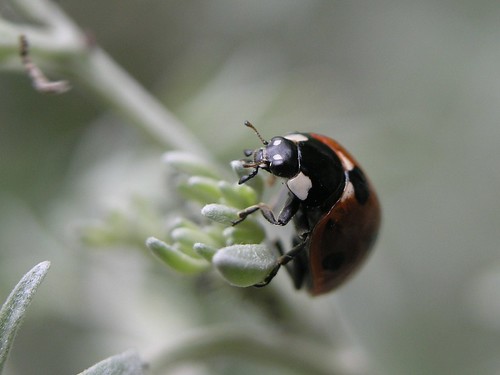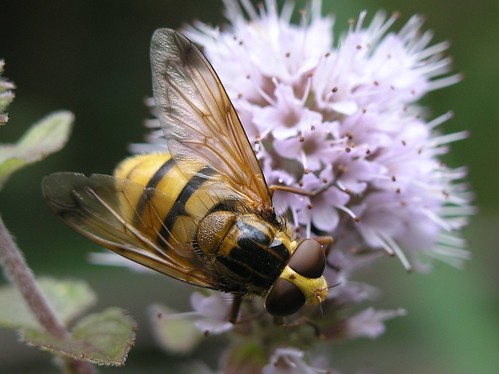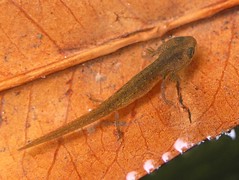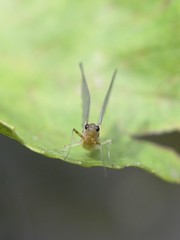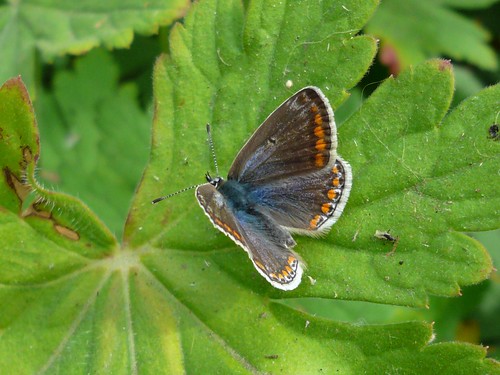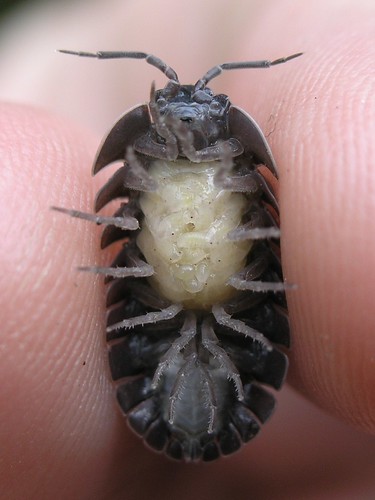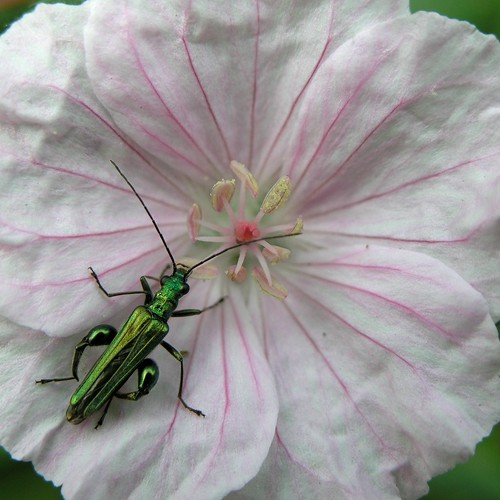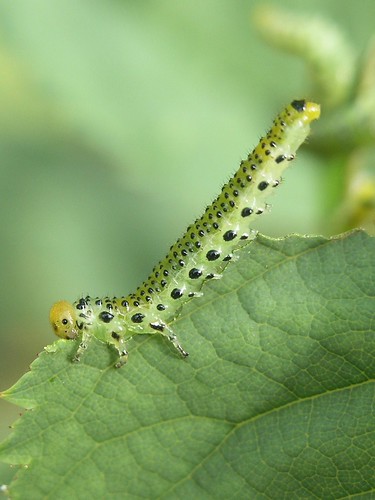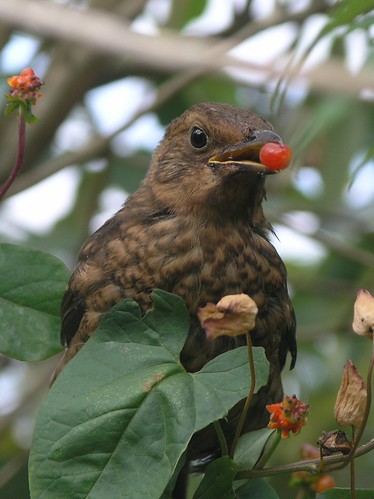In the north of the UK, this slug is predominately black, whereas here in the south is is predominantly yellow. It has a distinctive black and orange striped skirt and can get very large indeed. This individual was over 15cm long when at full stretch.
A couple of these big ones have drowned in the pond recently, so I steered this guy away as he seemed to be heading for the same fate. I guess they can't get to the beach area or onto the plants in time.
I've learned to grow things that can survive a slug and snail onslaught, or that they dislike eating, as I figure they have every right to be in my garden. They may repulse some people, but to me they are beautiful and wonderfully simple yet successful animals. Hopefully the pond will attract plenty of things to eat them and so control their numbers naturally.
Wednesday, 25 August 2010
Garden Slug (Arion ater)
Monday, 23 August 2010
7 Spot Ladybird (Coccinella 7-punctata)
I have an Artemisia that suffers from an annual invasion of cool black and grey aphids who sway in unison when disturbed. There are hundreds of them but amazingly the plant doesn't seem to be detrimentally affected. I can always be sure to find ladybirds on it, enjoying the banquet. This lovely 7-Spot was the latest visitor. Happily, I have seen plenty of native ladybird species this year and very few of the large invading Harlequins, unlike last year when the opposite was true.
Sunday, 22 August 2010
Hornet Hoverfly (Volucella Sp.)
A huge hoverfly, when I spotted it from across the garden I genuinely thought it was a hornet. It has a distinctive yellow face and smoky coloured wings. I'm not 100% sure of the species, but I'm sure it is a member of the Volucella genus which contains a variety of bee and wasp minics.
Garden Orb Spider (Araneus diadematus)
The Pond
Complete! The transplanted froglets, newtlets, larva and diving beetle are all doing great.
Many of the larva have hatched into beautiful mayflies; I even got to watch one emerge which was amazing.
The newts and froglets are loving hiding in the plants - there were none at all in their old (now removed) pond.
I've planted yellow flag iris, some dwarf reeds, corkscrew reed, frogbit, water soldiers, water hyacinths, water mint and more. Not all native, but they mostly are. My options at the local water garden shop were limited, and I needed oxygenating plants and surface cover asap for the amphibians. There is a lot of the single celled algae in the pond atm, so I need to try barley straw to reduce it. Once the pond finds a balance properly and the surface cover plants shade much of the water, the algae will be mostly self controlling.
Common Blue Butterfly (Polyommatus icarus)
Not one of my best pics, but I was delighted to see this pretty blue butterfly in the garden for the first time.
Pill Woodlouse (Armadillidium vulgare) with Young
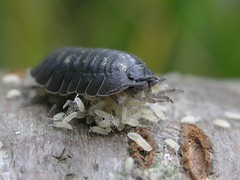
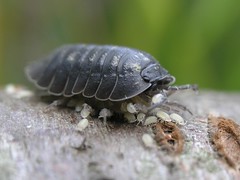
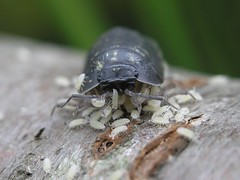
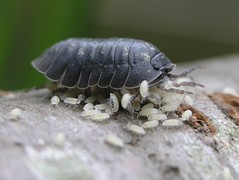
I have wanted to get photographs of this for years, and am thrilled that when I finally did they came out this well. Woodlice carry their eggs on their belly until hatching and the young go on their way. This pill woodlouse was fit to burst with hatched young. It always amazes me how so many babies fit into such a small space - when the egg sac bursts it is quite the explosion of young!
Common Darter Dragonfly (Sympetrum striolatum)
Wasp
This wasp comes to my pond for a drink, then flies off for a few minutes before returning to do it all again. This carries on for as long as I've watched it, hours in some cases. I'm guessing it needs the water for nest building or something, as it can't be thirsty all day!
Tuesday, 3 August 2010
Thick Legged Flower Beetle (Oedemera nobilis) Male
The male of this distinctive metallic green beetle shows the 'thick-legs' that give it its common name. The females do not have this feature. They eat pollen, usually very messily, and seem to love hardy geraniums and lavatera (mallow). Mating occurs in late spring/early summer.
Rose Sawfly (Arge pagana) Larva
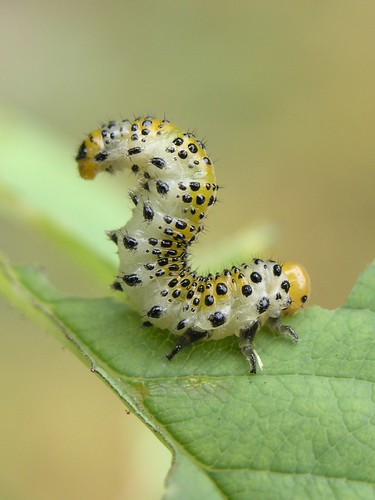
These are generally considered a pest of roses and other garden plants. The female lays eggs inside the plant stem and leaving a distinctive scar when the eggs hatch out. The larvae then decimate the plant they are on. I sacrificed a rose sucker to photograph these as they developed. Sticking their rear end in the air when threatened combined with striking colouring makes them very photogenic.
The Pond Takes Shape
Steps 1 & 2:


Steps 3 & 4:


I cannot begin to describe how excited I am. I have wanted a wildlife pond since I was a little girl, catching tadpoles from the local ditch to keep in a tank. My parents weren't so pleased about the hundreds of froglets that escaped all over the garden, getting in the veg patch and scaring my Auntie. I don't think a pond was ever really in their idea of a garden, let alone a wildlife one left to be messy and natural. With the 15-20 year old Cherry Tree at the end of the garden space was limited, but it sadly died (from unknown causes) and been removed. Redesigning options became available, leaving space for a pond at last! Something good coming from the death of a beloved and beautiful tree.
Our original plan was to place the pond next to the new shed at the end of the garden, but it felt too out-of-the-way. We've now decided to put our pond in a prime location next to the deck so we can watch it in comfort, though I suspect I'll spend most of my time laying on the ground with my nose (and camera) a few centimetres off the surface. It was scary having to dig out loads of beautiful established herbaceous perennials and find new spaces for them, and sadly a few haven't made it, but any excuse to go and buy more is welcome! I managed to see a lot of cool species when digging the deep hole too, including several species of centipede, beetles, worms, various larvae, harvestmen etc.
So excited!
Field Grasshopper (Chorthippus brunneus)
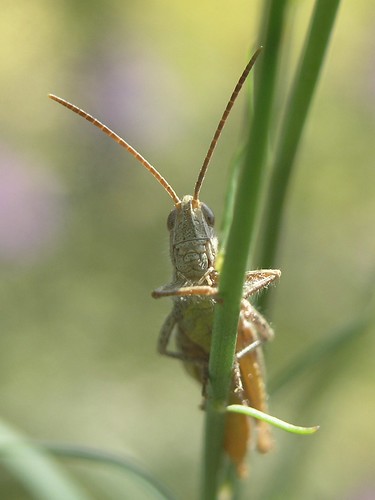
Field Grasshopper (Chorthippus brunneus), originally uploaded by Pipsissiwa.
Identification via mountainashe (Ashley Wood) from Wild Things / Chinery / McGavin.
A grasshopper doing what they always do, hiding on the other side of a thin stem and thinking they can't be seen. The way light reflects on their huge eyes makes a 'false pupil' effect, giving them cute, slightly shifty-looking expressions.
Blackbird (Turdus merula) Fledgling
Every year blackbirds nest in the bushes at the end of the garden, so I get treated to an annual spectacle of beautiful youngsters. This one was cautiously enjoying honeysuckle berries and kept me company as I painted the new shed. With just a trace of 'baby beak' it's almost grown up.

